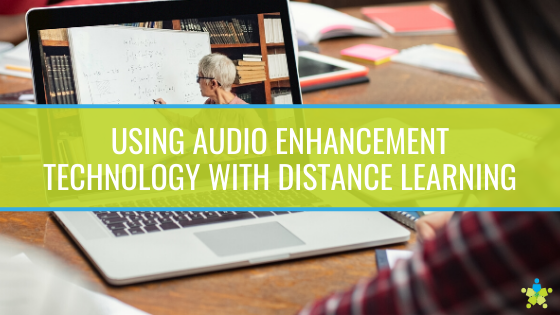As the new school year approaches, educators are preparing for more distance learning, and looking to audio enhancement technology to improve their online lessons. With audio enhancement, students can hear the teacher better, whether that teacher is in the same room wearing a mask or delivering a lesson through a video. This has quantifiable benefits on a student’s ability to learn, as most people learn best when integrating visuals and sound together.
In fact, multiple studies in U.S. schools demonstrate that audio enhancement can boost student test scores. And that’s just the beginning of what audio enhancement can do.
How does audio enhancement work?
Audio enhancement uses beamforming microphones to output optimal speaking volumes and frequencies. While in use, the microphone array detects where sounds are coming from, their volume and their frequency. The array interprets these audio signals and removes the ones that are interfering with the speaker’s voice. What’s left is the important audio, including the teacher’s lesson. If necessary, this audio is amplified so it is easy for people to understand without the teacher needing to raise their voice.Modern audio enhancement solutions can come with a camera, making for a convenient, all-in-one solution that schools find easier to utilize.
What are the advantages of audio enhancement solutions?
There are several benefits that come along with better audio. For example:
Sharper pronunciation
Typical human speech can be broken into many “phonemes,” or distinct sounds. Some of these sounds, like those produced by the letters g, n and r, are easy to pick out from other audio. Other sounds, like those produced by the letters f and s, along with the digraph th, are much more difficult to discern when interfering noise is present. These are important sounds that need to get through for students to understand their lessons. Audio enhancement ensures these quieter phonemes aren’t lost, so the teacher is interpreted correctly.
Less stress on the student
If audio is poor, students are forced to fill in the blanks where needed. In addition to misinterpreted lessons, this also distracts the student, which makes it harder to pay attention and can produce stress. If students have to replay a lesson segment over and over, they are taken out of the learning experience and may not perform as well.
Reduces the likelihood of learning helplessness
Learned helplessness is a noted phenomenon in education, and it is made worse by weak audio.Learned helplessness occurs when an educational environment is so poor that a student no longer believes they can learn in it. These students may permanently unplug from their studies, falling further and further behind because of a problem that may be correctable. Poor audio is a major driver of learned helplessness, as according to several studies, up to 33 percent of students have trouble hearing their teacher in a typical classroom. Before long, these students stop straining to hear their teacher and focus on other things.Audio enhancement brings these students back into the lesson, removing frustrating barriers to the lesson and ensuring they have the environment needed to learn properly.
Protects the teacher’s voice
A vastly underreported issue in U.S. classrooms is the vocal strain. According to a study published in the International Journal of Language and Communication Disorders, teachers are 32 times more likely to develop voice problems, compared to other professionals. The National Institute of Health has even stepped in to help with vocal strain, offering tips to teachers on how to protect their speaking voice during lessons.Audio enhancement protects the teacher from this strain, as there is no need to raise your voice while using the microphone. Educators can speak comfortably, remain focused on the lesson and need fewer off days to recover their voice.
Preserves audio even when a mask is worn
While some masks don’t alter the acoustic quality of a teacher’s voice, they can still interfere with communication by removing facial expressions and altering the way a teacher uses their face muscles to speak. Audio enhancement helps offset these obstacles by preserving quality audio, even when a mask is worn.
What does audio enhancement technology look like?
Modern audio enhancement solutions are designed for educators, including educators that provide distance learning. As distance learning also requires video streaming or recording capabilities, these solutions include a high-quality camera along with the microphone array.One such solution is AudioEnhancement’s VIEWpath all-in-one solution. It comes with three components, which include:
The EduCamPTZ
The EduCamPTZ is a 4-megapixel camera with 4x optical zoom and full pan-tilt-zoom control. Any video captured by the EduCamPTZ can be downloaded or delivered live, so it can be used with a variety of video management and delivery platforms.
The BEAM
The BEAM is an all-in-one audio technology that is designed to work with current generation microphones. It includes a portable speaker and an integrated receiver and amplifier.
The XD Teacher Microphone
The XD Teacher Microphone is a portable microphone designed to be worn by the teacher. It automatically detects when the teacher is speaking and delivers quality audio throughout the classroom or through video. There are tangible benefits to audio enhancement and easy-to-integrate solutions that can deliver all of them. Whether your district is transitioning to a distance learning framework or welcoming students back to the classroom, an audio enhancement solution will boost student attention and, by extension, their performance.



